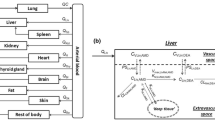Summary
The aim of this study was to characterise the pharmacokinetic disposition and tissue distribution of BRB-I-28 (7-benzyl-7-aza-3-thiabicyclo[3.3.1]nonane hydroperchlorate) in rats. The pharmacokinetic disposition was studied by collecting blood samples before and at frequent intervals after intracardiac or oral administration of 14C-labelled BRB-I-28. Two-compartment and 1-compartment pharmacokinetic models were used to describe blood concentration-time profiles after intracardiac and oral administration, respectively. After intracardiac administration, the half-life of elimination (t1/2β)from blood ranged from 4.66 to 9.91 hours and the apparent volume of distribution (Vd(area)) ranged from 3.131 to 6.239 L/kg. Oral dosing resulted in rapid and extensive absorption (bioavailability ± 80%). Distribution of radioactivity into heart, kidney, brain, liver, and perirenal fat was measured by sacrificing rats at various time intervals after oral administration of 14C-labelled BRB-I-28. Extensive distribution of radioactivity occurred in highly perfused organs, particularly liver, kidney and heart. However, levels of radioactivity in brain were low.
Similar content being viewed by others
References
Akaike H. A new look at the statistical model identification. Institute of Electrical and Electronics Engineers (IEEE) Transactions on Automatic Control AC-19: 716–723, 1974
Bailey BR, Berlin KD, Holt EM, Scherlag BJ, Lazzara R, et al. Synthesis, conformational analysis, and antiarrhythmic properties of 7-benzyl-3-thia-7-azabicyclo[3.3.1]nonane-9-one, 7-benzyl-3-thia-7-azabicyclo[3.3.1] nonane hydroperchlorate, and 7-benzyl-9-phenyl-3-thia-7-azabicyclo[3.3.l]nonan-9-ol hydroperchlorate and derivatives: single crystal X-ray diffraction analysis and evidence for chair-chair and chair-boat conformers in the solid state. Journal of Medicinal Chemistry 27: 758–767, 1984
Bigger JT, Hoffman BF. Antiarrhythmic drugs. In Gilman et al. (Eds) The pharmacological basis of therapeutics, pp. 748–783, Macmillan Publishing Company, New York, 1985
Bourne DWA. Multiforte, a microcomputer program for modelling and simulation of pharmacokinetic data. Computer Methods and Programs in Biomedicine 23: 277–281, 1986
Boxenbaum HG, Riegman S, Elashoff RM. Statistical estimations in pharmacokinetics. Journal of Pharmacokinetics and Bio-pharmaceutics 2: 123, 1974
Edwards CH, Penny DE. In Calculus and analytical geometry, Prentice-Hall, Englewood Cliffs, New Jersey, 1982
Gustafsson LL, Walker O, Alvan G, Beermann B, Estevez F. Disposition of chloroquine in man after single intravenous and oral doses. British Journal of Clinical Pharmacology 15: 471–479, 1983
McGovern B, Garan H, Kelley E. Adverse reactions during treatment with amiodarone hydrochloride. British Medical Journal 287: 175–180, 1983
Nygaarde TW, Sellers D, Cook TS, DiMarco JP. Adverse reactions to antiarrhythmic drugs during therapy for ventricular arrhythmias. Journal of the American Medical Association 256: 55–57, 1986
Rakhit A, Holford NHG, Guentert TW, Maloney K, Riegelman S. Pharmacokinetics of quinidine and three of its metabolites in man. Journal of Pharmacokinetics and Biopharmaceutics 12: 1–21, 1984
Scherlag BJ, Patterson E, Lazzara R, Bailey BR, Thompson MD, et al. Comparative electrophysiological and hemodynamic actions of BRB-I-28 and lidocaine in the normal and infarcted dog heart. Journal of Electrophysiology 2: 461–477, 1988
Schwartz JB, Keefe D, Harrison DC. Adverse effects of antiarrhythmic drugs. Drugs 21: 23–24, 1981
Webster LT. Drugs used in the chemotherapy of protozoal infections. In Gilman et al. (Eds) The pharmacological basis of therapeutics, pp. 1029–1048, Macmillan Publishing Company, New York, 1985
Yamaoka K, Nakagawa T, Uno T. Application of Akaike’s information criterion (AIC) in the evaluation of linear pharmacokinetic equations. Journal of Pharmacokinetics and Biopharmaceutics 6: 165, 1978
Zisman SA, Berlin KD, Alavi FK, Sangiah S, Clarke CR, et al. Synthesis of 7-benzyl-7-aza-3-thiabicyclo[3.3.1]nonane hydro-perchlorate-6,8,10-14C 3. Journal of Labelled Compounds and Radiopharmaceuticals 27: 885–888, 1989
Author information
Authors and Affiliations
Rights and permissions
About this article
Cite this article
Alavi, F.K., Clarke, C.R., Sangiah, S. et al. Disposition of BRB-I-28 (7-benzyl-7-aza-3-thiabicyclo[3.3.1]nonane hydroperchlorate), a Novel Antiarrhythmic Agent. Drug Invest. 3, 317–323 (1991). https://doi.org/10.1007/BF03259745
Published:
Issue Date:
DOI: https://doi.org/10.1007/BF03259745



